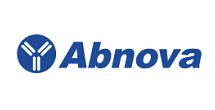ITGAV monoclonal antibody, clone ABGC-9



* The price is valid only in USA. Please select country.
-
More Files
- More Functions
-
Specification
Product Description
Rabbit monoclonal antibody raised against synthetic peptide of human ITGAV.
Immunogen
A synthetic peptide corresponding to human ITGAV.
Host
Rabbit
Theoretical MW (kDa)
116.038
Reactivity
Human
Form
Liquid
Purification
Affinity purification
Isotype
IgG
Recommend Usage
Immunocytochemistry (1:50-1:200)
Immunofluorescence (1:50-1:200)
Immunohistochemistry (1:50-1:200)
Immunoprecipitation (1:40)
Western Blot (1:500-1:2000)
The optimal working dilution should be determined by the end user.Storage Buffer
In PBS, 150 mM NaCl, pH 7.4 (50% glycerol, 0.02% sodium azide).
Storage Instruction
Store at -20°C for one year. After reconstitution, at 4°C for one month. It can also be aliquotted and stored frozen at -20°C for a longer time. Avoid repeated freezing and thawing.
Note
This product contains sodium azide: a POISONOUS AND HAZARDOUS SUBSTANCE which should be handled by trained staff only.
-
Applications
Western Blot
Western Blot analysis of Lane 1: A549 cell, Lane 2: mouse spleen tissue and Lane 3: rat brain tissue lysates with ITGAV monoclonal antibody, clone ABGC-9 (Cat # MAB20388).Immunohistochemistry
Immunocytochemistry
Immunofluorescence
Immunoprecipitation
-
Gene Info — ITGAV
Entrez GeneID
3685Protein Accession#
P06756Gene Name
ITGAV
Gene Alias
CD51, DKFZp686A08142, MSK8, VNRA
Gene Description
integrin, alpha V (vitronectin receptor, alpha polypeptide, antigen CD51)
Omim ID
193210Gene Ontology
HyperlinkGene Summary
ITAGV encodes integrin alpha chain V. Integrins are heterodimeric integral membrane proteins composed of an alpha chain and a beta chain. The I-domain containing integrin alpha V undergoes post-translational cleavage to yield disulfide-linked heavy and light chains, that combine with multiple integrin beta chains to form different integrins. Among the known associating beta chains (beta chains 1,3,5,6, and 8; 'ITGB1', 'ITGB3', 'ITGB5', 'ITGB6', and 'ITGB8'), each can interact with extracellular matrix ligands; the alpha V beta 3 integrin, perhaps the most studied of these, is referred to as the Vitronectin receptor (VNR). In addition to adhesion, many integrins are known to facilitate signal transduction. Alternative splicing results in multiple transcript variants. [provided by RefSeq
Other Designations
Integrin, alpha-V (vitronectin receptor, alpha polypeptide)|antigen identified by monoclonal antibody L230|integrin alpha-V
-
Interactome
-
Pathway
-
Disease
- +1-909-264-1399
+1-909-992-0619
Toll Free : +1-877-853-6098 - +1-909-992-3401
- sales@abnova.com

















